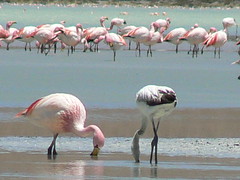Thousands of Flamingos
(Continued from day 2)
The half day drive to the Reserva Eduardo Avaroa took us through some wide mountainous landscapes. First stop was at an area covered with large-scale volcanic rock formations. The formations had many different shapes and only the imagination can limit the strange things you see in the rocks. We played around and ended with Barbara in a huge snake’s mouth! The playground also served as a great lookout point to the vaguely smoking Volcano Ollague which is the only active volcano in Bolivia (5865 m. high).
The bumpy ride continued on to a couple of the brackish lakes in the region: Laguna Cañapa and later Laguna Heidona. Both are located surrounded by reddish mountains and have a rich flamingo-life.
Sitting down at the edge of the lakes, embraced by the mountains and the silence you slowly absorb the beautiful look of thousands of flamingos looking for a snack in the blue-white still water. Magic for sure.
Three of the worlds five different kind of flamingos live here: Chilense, Andino and James. How you see which one is which, is by the colour of their tail, their legs and their beaks. From a distance it can be really difficult though to differ one from another.
The volcanoes surely left a lot of foot prints in this region and we made another stop to explore some of them. Again this was big dimension volcanic rocks. This time the rocks were all aligned with a special plant clinched on the sides of them. The plant is a kind of moss, but very hard. As a replacement to ordinary wood, this plant used to be dried and used as fuel for the trains etc. The plant grows several meters tall and gets hundreds years old. The bright green colour made a grand contrast to the reddish volcanic rocks.
In 4700 meters above sea level the landscape turned into a desert. Few yellowish plants scattered around, the reddish dirt, the almost purple mountains were stretched to all sides and once in a while a small flock of vicuñas crossed the road.
Time for the second biggest landmark on the trip: Arbol de Piedra. (The salt lake is bound to be the first). Arbol de Piedra meaning Stone Tree is an eight meter tall rock which balances on a narrow stem. The rock has for many years been carved by the sand and the wind which have ended up given it a form like an abstract Dali-tree. Beautiful – in a weird way.
Last stop that day was Laguna Colorada located at 4000 m. Colorada means colorful and so it was! Most bizarre was the almost blood red water, due to a high level of beta-carotene. Starring out on the blood red water made you realize that everything is possible! Nothing should be assumed.
Laguna Colorada is also the worlds biggest single nesting site for flamingos, meaning that up to 70.000 flamingos are in the lake at one time during the nesting season! Right now it is not the nesting season though, so we only counted around 30-40.000 flamingos nip in the water, flying in small groups, crossing beaks (kiss?) and enjoying the sun.
The white ones we saw, was the babies... Not fed up on beta-carotene yet.
The Laguna Colorada is near the official entrance to the Reserva Eduardo Avaroa where we were going to spend our last day. The sun was going down though so we stopped for the night in a chilled dorm.
(To be continued.)


0 Comments:
Post a Comment
<< Home